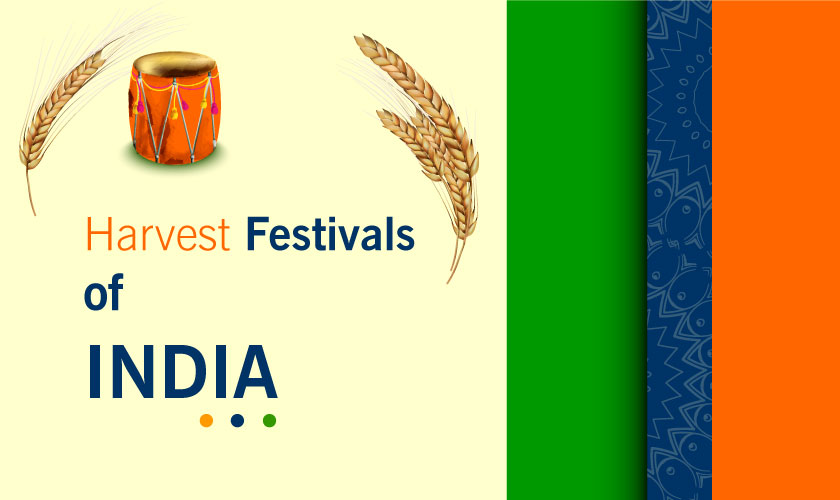Indians celebrate many harvest festivals every year. Harvest festivals in India are a colourful tapestry woven from the threads of agricultural heritage and cultural diversity. These festivals transcend regional boundaries, binding communities together in a celebration of nature’s generosity and the hard work of farmers. We are here to talk about the Harvest festivals of India, and the significance of harvest festivals, and celebrations.
What is Harvest Festival?
The majority of the Indian population live in villages. Their livelihood depends on agriculture. Thus there are different harvest festivals in India. India celebrates many important harvest festivals every year.
Why Do We Celebrate Harvest Festivals in India?
Farmers also enjoyed their work and they celebrated it in the form of festivals. The hard work of farmers along with family members has given the results. People harvest their crops from the field and bring them to their homes. They are kept in the safest place in the home. After harvesting their crop, they celebrate harvest festivals.
Significance of Harvest Festival
Harvest festivals hold immense cultural and spiritual significance in India. They are not merely occasions to express gratitude for a successful harvest but also to seek blessings for future agricultural endeavours. These festivals are connected to nature, food, and animals. These festivals symbolize the cyclical nature of life, emphasizing the interconnectedness of humans and the environment. The Indian Harvest Festival plays a significant role in farmers’ lives.
Harvest Festival Signify the Start of the New Year
Cultural diversity in India can be seen based on local cultural beliefs and traditions. Based on the local culture and tradition, harvest festivals signify the start of the New Year in many cultures.
Tamil New Year Start with Pongal which marks the beginning of the Tamil month called Thai which is considered an auspicious month. Ugadi is a New Year celebration in Andhra, Telangana, and Karnataka.
Harvest Festival Signify the Start of Harvest Season
All these festivals are based on their local harvest season. Those regions which are involved in agricultural practices plan their respective harvest seasons. Lohri festival signifies the end of winter and the beginning of a new harvest season.
Thanking Mother Nature for Good Harvest
Nature has given us everything for life on earth. Harvest festivals are the celebration to thank the Sun, Mother Nature, and the various farm animals who help to contribute to a bountiful harvest. Through Harvest festivals, farmers perform rituals to thank Mother Nature.
Diversity of Harvest Festival in India
The diversity of Harvest festivals depends upon the season. Harvest festivals vary according to geographical location. Harvest festival celebrations are deeply connected to the local culture and tradition. The South Indian harvest festivals are celebrated differently than North Indian harvest festivals. The same festival is celebrated with different names at different locations. e.g. Makar Sankranti is celebrated with different names at different locations. Checkout:- List of Harvest Festivals in India
Harvest Festivals of North India
Some of the major harvest festivals in India are Makar Sankranti, Pongal, Uttarayana, Lohri, and Bhogali Bihu. These festivals are mostly celebrated in North India. These festivals are celebrated in Punjab, Haryana, Delhi, Uttarakhand, Uttar Pradesh, and Bihar.
Harvest Festivals of South India
The South Indian harvest festivals are different from North Indian harvest festivals. Pongal, Onam, and Ugadi are the famous harvest festivals of South India. These festivals are celebrated in Tamil Nadu, Kerala, Karnataka, and Telangana. All these festivals help one know about the culture of South India.
Harvest Festival Celebration
When the crop season starts and farmers are ready to harvest their crops in the field, excitement can be easily felt on their faces. We can easily see the excitement on every farmer’s face when they are going to harvest their crop in the field. They celebrate this moment in the form of festivals.
Rituals and Traditions
The preparation for harvest festivals involves a range of rituals and traditions:
The harvest festivals in India involve customary traditions and joyous celebrations. From the start of digging the seeds into the field to the crop season, small or large festivals are organized.
Decorating Homes and Farms
Homes and farms are adorned with Rangoli, flowers, and vibrant decorations to welcome the harvest season.
Offerings to Deities
Farmers offer the first yield to deities as a token of gratitude. Temples come alive with devotional fervour during these festivals.
Folk Dances and Music
Folk dances like Bhangra, Garba, and Bihu add a lively rhythm to the celebrations, reflecting the joy of a successful harvest.
Community Feasts
One of the highlights of these festivals is the elaborate feasts that bring families and communities together, sharing delectable traditional dishes.
Cultural Insights: Beyond Crops
Harvest festivals are not only about crops; they also showcase the rich cultural heritage of different regions. They provide artisans, musicians, and performers a platform to display their talents.
The Joy of Togetherness
Harvest festivals exemplify the spirit of unity and togetherness. Regardless of caste, creed, or economic status, these celebrations erase divisions and foster communal harmony.
Preservation of Traditions in Modern Times
In the face of urbanization and changing lifestyles, these festivals play a crucial role in preserving traditional practices and passing them down to the younger generations.
Harvest Festivals and Environment
With growing concerns about the environment, these festivals are evolving to incorporate eco-friendly practices, promoting sustainability and raising awareness about nature.
Conclusion
India is also an agrarian country. Farmers are the backbone of the nation. Former Prime Minister Lal Bahadur Shastri has given a famous slogan i.e. Jai Javan Jai Kishan. This means farmers in India are given the same respect and honour as our armed forces. They do hard work throughout the year feed the nation and grow different grains and crops throughout the year. Harvest festivals bring joy and happiness to farmers’ faces. Their hard work in the field brings a good harvest and hence they need to celebrate together.
India’s harvest festivals are a testament to the country’s deep-rooted agricultural heritage and cultural diversity. They paint a vivid picture of communities coming together to celebrate nature’s bounty and express gratitude. These festivals remind us of the interdependence between humans and the environment and the importance of preserving traditions in a rapidly changing world.
FAQs
- Why are harvest festivals important in India?
Harvest festivals hold cultural, spiritual, and agricultural significance, celebrating nature’s abundance and fostering community bonds.
2. What are some common dishes served during Harvest festivals?
Traditional dishes like Pongal, Makki di Roti with Sarson da Saag, and Onam Sadhya are commonly served.
3. How do modern harvest festivals promote sustainability?
Many festivals are incorporating eco-friendly practices, such as using organic materials for decorations and promoting responsible consumption.
4. Do these festivals have religious connotations?
Yes, many of these festivals have religious roots and are intertwined with local myths and legends.
5. Are harvest festivals only celebrated in rural areas?
No, these festivals are celebrated across urban and rural areas, showcasing their cultural significance beyond agriculture.



